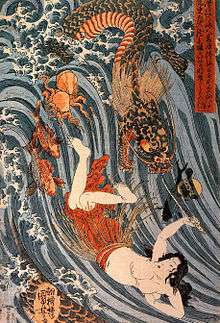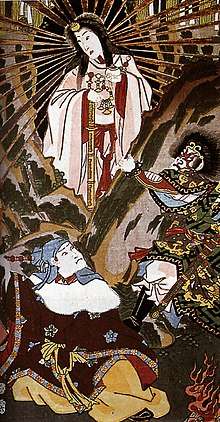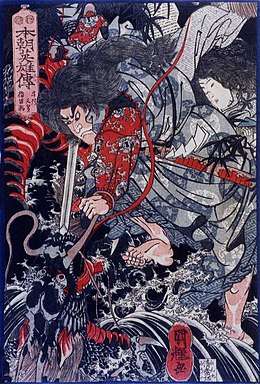Ryūjin
Ryūjin or Ryōjin (龍神, "dragon god"), which in some traditions is equivalent to Ōwatatsumi, was the tutelary deity of the sea in Japanese mythology. This Japanese dragon symbolized the power of the ocean, had a large mouth, and was able to transform into a human shape. He is considered a good god and patron of Japan, since the Japanese population for several centuries lives off the sea and seafood. Ryūjin is also credited with the challenge of a hurricane that sunk the Mongolian flotilla sent by Kublai Khan. Ryūjin lived in Ryūgū-jō, his palace under the sea built out of red and white coral, from where he controlled the tides with magical tide jewels. Sea turtles, fish and jellyfish are often depicted as Ryūjin's servants.

Ryūjin was the father of the beautiful goddess Toyotama-hime who married the hunter prince Hoori. The first Emperor of Japan, Emperor Jimmu, is said to have been a grandson of Otohime and Hoori's. Thus, Ryūjin is said to be one of the ancestors of the Japanese imperial dynasty.
Alternative legends
According to legend, the Empress Jingū was able to carry out her attack into Korea with the help of Ryūjin's tide jewels. Upon confronting the Korean navy, Jingū threw the kanju (干珠, "tide-ebbing jewel") into the sea, and the tide receded. The Korean fleet was stranded, and the men got out of their ships. Jingū then threw down the manju (満珠, "tide-flowing jewel") and the water rose, drowning the Korean soldiers. An annual festival, called Gion Matsuri, at Yasaka Shrine celebrates this legend.
Another legend involving Ryūjin is the story about how the jellyfish lost its bones. According to this story, Ryūjin wanted to eat monkey's liver (in some versions of the story, to heal an incurable rash), and sent the jellyfish to get him a monkey. The monkey managed to sneak away from the jellyfish by telling him that he had put his liver in a jar in the forest and offered to go and get it. As the jellyfish came back and told Ryūjin what had happened, Ryūjin became so angry that he beat the jellyfish until its bones were crushed.
In Shinto
Ryūjin shinkō (竜神信仰, "dragon god faith") is a form of Shinto religious belief that worships dragons as water kami. It is connected with agricultural rituals, rain prayers, and the success of fishermen.
External links
- Ryūjin shinkō, Encyclopedia of Shinto
- Netsuke: masterpieces from the Metropolitan Museum of Art, an exhibition catalog from The Metropolitan Museum of Art (fully available online as PDF), which contains many representations of Ryūjin
![]()

